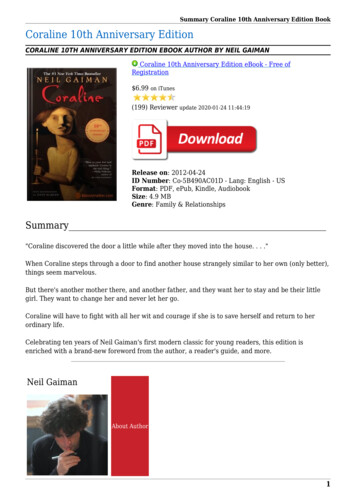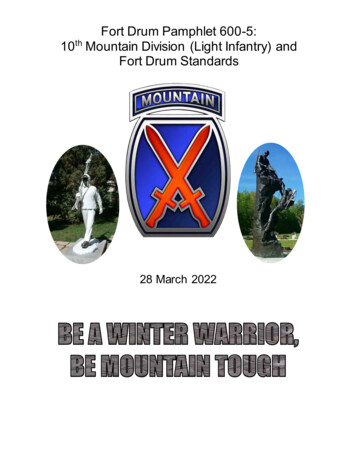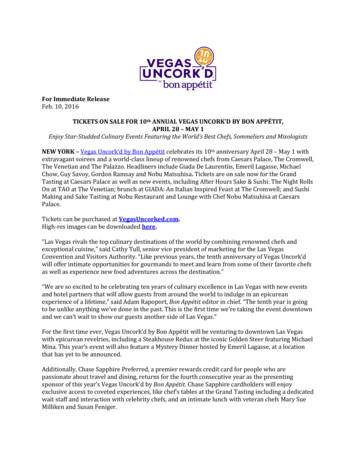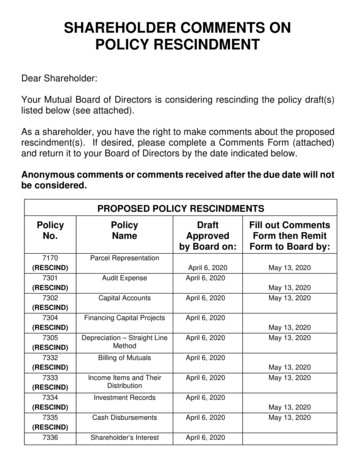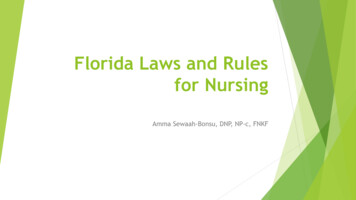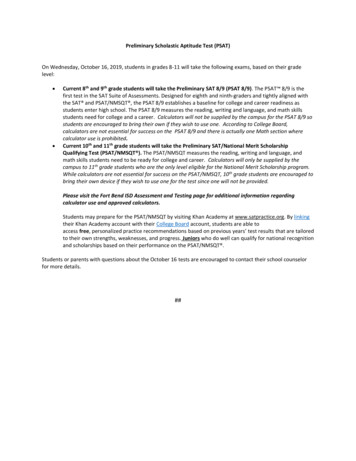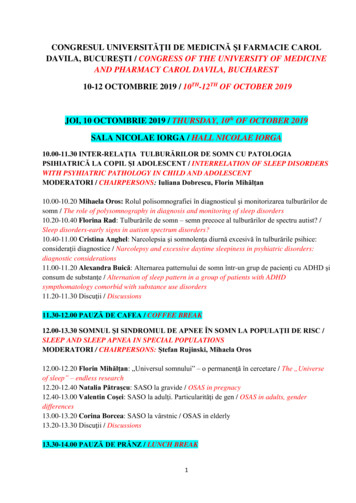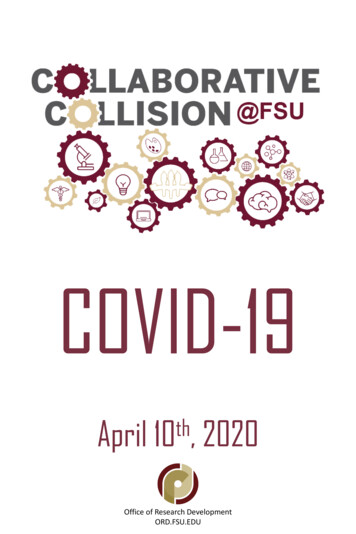
Transcription
thApril 10 , 2020Office of Research DevelopmentORD.FSU.EDU
Thank you to all who attended this event, whetheras presenters or just listening in. This PowerPointpresentation is being sent to all those whoregistered for the event today, along with aspreadsheet of contact information.If there is anything else the Office of ResearchDevelopment can do to help facilitate conversations,or help develop your projects, please do not hesitateto reach out to us.Mike MitchellProgram ManagerStrategic Initiatives andProposal DevelopmentMike.mitchell@fsu.eduBeth HodgesDirectorOffice of Research Developmentbhodges@fsu.edu
Welcome RemarksDr. Gary OstranderVice President for ResearchCollaborative Collision OverviewMike MitchellProgram Manager for Strategic Initiatives andProposal DevelopmentParticipant PresentationsFSU Researchers and CommunityPartnersClosing RemarksBeth HodgesDirector, Office of Research Development
How Collaborative Collision Works All participants are muted, and chat is disabled. If there is an urgent issue, please email mike.mitchell@fsu.edu Presenters have the option to enable or disable theirown video. Each presenter has three minutes to discuss theirbackground, and COVID-19 project. Host will unmute presenters when it is their turn, andre-mute them when their time is up. All participants will receive a copy of thepresentations, and a list of all those who attendedwith contact information. ORD will facilitate discussions after the event
Order of 7.18.19.20.21.Qinchun RaoRobert Tomko Jr. (Robb)Shawn KantorJingjiao GuanYuan WangAngelina (Gina) SutinBruce R. LockeBranko StefanovicKristina BuhrmanHengli TangJoe SchlenoffDavid G. Meckes JrLaura Reid MarksGregg StanwoodBill WeissertYue Julia WangHongyuan CaoGuangxin NiJamel AliKatrinell M. DavisLeslie Powell-Boudreaux21. Zhe He22. Kelly Farquharson23. Shuyuan Mary Ho24. Xiuwen Liu25. Jonathan Dennis & Juan R. Reza26. Frankie Wong27. Gordon Erlebacher28. Amanda Driscoll29. ExpertNet30. Alva Striplin31. Jose Renato Pinto32. Krissy Capitano33. Machelle Madsen Thompson34. Richard Nowakowski35. Svetlana Pevnitskaya36. Anke Meyer-Baese37. Zucai Suo38. Yanshuo Sun
Up Next: Robb Tomko
Robert Tomko Jr. (Robb)Dept of Biomedical Sciences, FSU-COMrobert.tomko@fsu.eduResearch Interests Proteolysis Ubiquitin and ubiquitin-like proteins Drug discoveryBackground InformationWe use biochemistry, biophysics, molecular modeling, genetics, and cell biology to study medicallyimportant aspects of the ubiquitin system. Ubiquitin signaling is frequently co-opted or disrupted bypathogens. Betacoronaviruses contain a protease with two functions critical for viral replication. First,this protease cleaves a large viral polyprotein into functional units. Second, it removes ubiquitin andubiquitin-like proteins from host cell proteins (and likely also viral proteins) to suppress the host cell’simmune response. We are interested in identifying small molecule inhibitors of this protease as leadcompounds for development into therapeutics. We have established several in vitro activity assays forthis protease and are working to convert them into a high-throughput screen for inhibitors.How I Can Help a COVID-19Related ProjectHow Someone Can Help MyCOVID-19 ProjectExpertise: Ubiquitin system Protein degradation and homeostasis Assembly of multisubunit complexes Protein-protein interactionsExpertise: Medicinal chemistry Computational drug screening orcomputational molecular docking VirologySkills and tools: Ubiquitin/ligase/protease reagents Protein expression and purification Enzymology and functional assays Assay design and miniaturization Fluorescence spectroscopy Atomic/molecular modelingSkills and tools: Access to small molecule, naturalproduct, or peptide/peptoid libraries Organic synthesis Cell-based models of coronavirusinfection or pathogenesisAdditional ContentMolecular modelingSelectivity and mutational analysisActivity assayand kineticsDrug discoveryUp Next: Shawn Kantor
Shawn KantorEconomics & Hilton Centerskantor@fsu.eduResearch Interests: Economic impacts of crises and policyresponses Impact of social insurance on localeconomies Regional economic developmentBackground InformationShawn Kantor is the L. Charles Hilton Jr. Distinguished Professor of Economics and Director of theCOSSPP’s Hilton Center for the Study of Economic Prosperity and Individual Opportunity. Researchinterests and experience relevant to Covid-19 relate to the impact of economic crises on local economiesand the subsequent effects of fiscal policy responses. Past work that relates to this question examinedthe impact of New Deal spending on a variety of important economic and social outcomes, such as infantmortality, migration, labor market responses, crime, and macroeconomic effects. His work has beenextensively supported by external grant agencies, primarily the National Science Foundation.How I Can Help a COVID-19Related Project Interdisciplinary approach to studyingeconomic issues, especially related toeconomic crises and policy responsesEconometric research experienceAccess to research support (students &seed funding)Long history of funding from federalagenciesExperience publishing in top journalsHow Someone Can Help MyCOVID-19 Project Raise new research questions fromalternative disciplinary perspectivesAccess to interesting dataMotivation to add an economic / socialscientific element to an interdisciplinaryprojectAdditional ContentUp Next: Jingjiao Guan
Jingjiao GuanDepartment of Chemical and BiomedicalEngineering, FAMU-FSU College ofEngineeringguan@eng.famu.fsu.eduResearch Interests Developing a Novel Vaccine AdjuvantPlatform for COVID-19Background Information Messenger RNA (mRNA) is a promising candidate vaccine antigen for developing a COVID-19vaccine A clinically proven adjuvant for mRNA vaccine does not exist. An effective adjuvant system requires a high efficiency in cytosolic delivery of mRNA and an abilityto activate the immune system of the host. Meeting both requirements is challenging for the conventional adjuvants, but it is attainable byusing a top-down microfabrication technique developed by the PI of this proposal and coworkers.How I Can Help a COVID-19Related Project We have preliminarily established anovel method for delivery ofmacromolecules into cytosol ofmacrophagesThe method is based on top-downmicrofabrication of microparticles withPNIPAM, which is a temperaturesensitive polymer.The method can potentially be modifiedto deliver mRNA to antigen-presentingcells including macrophages anddendritic cellsHow Someone Can Help MyCOVID-19 Project We need someone with expertise indeveloping vaccinesAdditional Content(A) Design of the proposed mRNA vaccine platform. (B) Envisioned process of action.Up Next: Yuan Wang
Yuan WangDepartment of Biomedical Sciences,College of Medicineyuan.wang@med.fsu.eduResearch Interests Brain development Prenatal environmental exposure &genetic mutations (e.g., autism) Sensory information processingBackground InformationMy long-term research interest is to explore principle mechanisms that guide the development of ahealthy brain, by determining how brain units (neural circuits) become structurally and biochemicallyspecialized during development and how a disruption of this process leads to neurological disorders.We use molecular, neuroanatomical, and physiological approaches to investigate neuronaldevelopment and dynamics under normal and pathological conditions, both in animal models and inhuman tissue.How I Can Help a COVID-19Related ProjectCharacterize acute and long-lasting effectsof COVID-19 exposure to prenatal andpostnatal brain developmentHow Someone Can Help MyCOVID-19 ProjectProvide brain tissue samples fromexperimental animals that are exposed toCOVID-19 as well as their offspring.Additional Content COVID-19 may spread from moms to infants: althykids Prenatal exposure to virus increases the chance to a number of neurological disorderslater in the 3222883/Up Next: Gina Sutin
Angelina (Gina) SutinBehavioral Sciences and Social MedicineAngelina.sutin@med.fsu.eduResearch Interests Personality Subjective well-being Cognitive agingBackground InformationMy research focuses broadly on psychological traits and well-being and cognitive aging. My groupcurrently has a study of participants who were tested the first week of February and then againapproximately 6 weeks later during the President’s initial 15 Days to Slow the Spread guidelines. We areexamining acute changes in psychological, emotional, and social well-being in response to COVID-19, aswell as predictors of behavior change and concerns about the pandemic. I am interested in developingmore research on how social distancing is affecting the well-being of older adults, particularly thosealready at high risk for loneliness.How I Can Help a COVID-19Related ProjectHow Someone Can Help MyCOVID-19 ProjectExpertise in trait psychological functioningand well-beingAccess to nursing homes or other agingpopulationsExpertise in older adulthood and otherhigh-risk populationsExpertise in communicationExpertise in dyadsPotential administrative supplement forCOVID-19-related workAdditional ContentUp Next: Bruce Locke
Name: Bruce R. LockeDepartment: Chemical and BiomedicalEngineeringEmail Address: locke@eng.famu.fsu.eduResearch Interests Interest 1: non-thermal plasma reactoranalysis and design Interest 2: chemical reactions in gasliquid plasmaBackground InformationWe conduct research in the area of non-thermal plasma, a type of plasma state where the energy of thefree electrons is much higher than that of the background gas. When contacting the plasma with liquidwater we generate a range of reactive oxygen species (ROS)(hydroxl radicals , atomic oxygen andhydrogen peroxide) and reactive nitrogen species (RNS) (when using air as the carrier gas we generateperoxynitrite, nitric acid, and other nitrogen oxides). These species are known to have anitmicrobial andantiviral activity.How I Can Help a COVID-19Related ProjectHow Someone Can Help MyCOVID-19 ProjectWe are constructing small portable plasmareactor systems that can be used fordisinfection and that require only electricity,air, and water to generate the ROS and RNS.I am seeking collaborators who can assist intesting our reactor for destruction ofviruses.Recent publications describing our system oi.org/10.1088/1361-6463/ab431aAdditional ContentUp Next: Branko Stefanovic
Branko StefanovicCollege of Medicine, Biomedical Sciencebranko.stefanovic@med.fsu.eduResearch Interests:Mechanism of fibrosisAntifibrotic drugsBackground InformationMy research is focused on elucidation of the molecular mechanism of tissue fibrosis and finding specificantifibrotic drugs. We have recently described one antifibrotic compound and its efficacy in hepatic fibrosis.This is to extend the use of this compound in COVID-19 induced cardiac fibrosis. Myocarditis is commonlyassociated with viral infections. Cardiac complications of influenza virus, including fibrosis, have been found in48% of fatal cases of influenza. Dissemination of influenza virus into the heart is 3 days post-infection. Severeacute respiratory syndrome coronavirus 2 (SARS-CoV-2) is also causing acute myocardial injury and chronicheart damage (Nature Reviews Cardiology (2020). Chronic heart damage results from fibrosis development.This is why cardiac patients are severely affected by COVID-19 infection.How I Can Help a COVID-19Related Project Treatment with our antifibrotic drug at theonset of COVID-19 infection may preventfibrotic heart damage after the infection. IFN-induced transmembrane protein 3 (IFITM3)knock out (KO) mouse will be used as a modelto study cardiotoxic effects of COVID-19. Thismodel has been used to study cardiotoxcicity ofinfluenza virus. The KO mice will be treated with our drug at theonset of COVID-19 infection and cardiac fibrosiswill be assessed at various times postinfection.How Someone Can Help MyCOVID-19 Project Propagate the virus Determine the virus titer Help with the animal model Assess the cardiac function This will validate the drug as cardioprotective inCOVID-19 infections.Additional ContentThis is an opportunity to assess if cardio-protection is possible during COVID-19 infection. Itwill use our proprietary antifibrotic compound and a well-established mouse model of viralcardiotoxicity. The project is feasible at FSU if the appropriate biosafety level can beprovided.Up Next: Kristina Buhrman
Kristina BuhrmanReligionkbuhrman@fsu.eduResearch Interests History of Science Community and Household Religious Life DisastersBackground InformationI have been researching historical disasters for 14 years (since while in graduate school). I am particularlyinterested in how disasters are categorized and responded to, and recently I have come to study howdisasters are remembered, memorialized, mobilized, and the effects a disaster has on a community as itrecovers or changes. After the Japanese tsunami of 2011, and with the current pandemic, I am nurturingresearch questions about the ways in which people adapt religious observances to displacement or socialdistancing. I have already presented and published on tsunami stones in Japan, and look forward to doingfollow up work on religious life among the displaced and returning communities. With COVID-19, I see aunique opportunity to do a longitudinal study of disaster and recovery on various communities.How I Can Help a COVID-19Related Project Identify new funding sources Help develop interdisciplinary grantproposals Bring connections to Japanese subjectsand communities Provide insight on the world’s religiouspractices and beliefs for sociological andpolitical studies; disaster planningstudies; international historical parallels Develop connections to non-FSUresearcher communities in ScienceTechnology and Medicine Studies,disaster studies, religious studiesHow Someone Can Help MyCOVID-19 Project Provide insights from other disciplinaryfields Develop interdisciplinary grant proposals Bring connections to other communitiesto research Bring links to other non-FSUcollaborators Help with Human Subject researchdesign and implementation (overinternet/phone initially) Identify funding sourcesAdditional ContentBuhrman, K. M. (in press). Monoimi: Days of Abstinence, Days of Danger. In Christina Laffin, Joan R. Piggott, &Yoshida Sanae (Eds.), Birth of a Monarch: Selections from Fuiwara No Munetada's Journal Chuyuki (7 pages).Ithaca, NY: Cornell East Asia Series.Buhrman, K. (2017). Remembering Future Risk: Considering Technologies of the Archive for Discussion ofTohoku's Seismological Past After 2011. Technology and Culture, 58(1), 159-169.Buhrman, K. (2017). Knowledge of Nature and Craft: Researching the History of Science, Mathematics andTechnology in Japan before 1600. In Karl Friday (Ed.), Routledge Handbook of Premodern Japanese History.London: Routledge.Up Next: Hengli Tang
Hengli TangBiological Sciencetang@bio.fsu.eduResearch Interests Virus-host interactions Stem cell technologies Intervention of viral infectionsBackground InformationMy lab studies emerging and re-emerging viruses that pose significant threats tohuman health. Researchers use molecular biology techniques and tissue culturemodels, including stem cell-derived 3-dimensional models, to investigate themechanisms by which significant human pathogens, such as Zika and dengue viruses,disseminate and cause diseases. Our research is supported by grants from NationalInstitute of Allergy and Infectious Diseases (NIAID).How I Can Help a COVID-19Related ProjectHow Someone Can Help MyCOVID-19 ProjectCell culture models for viral infectionPlatform to develop rapid serological assay forCOVID-19 diagnosticsSmall molecule candidate that can potentialinhibit SARS-CoV-2 replicationWe are developing, with an existingcollaboration with industry partner, a rapidserological test forCOVID-19, we are seekingpartners who have clinical samples to helpvalidate the testAccess to key scientists and labs engaging inCOVID-19 researchKnowledge related to various aspects of SARSCoV-2 biology, and RNA viruses in generalAdditional ContentOptional Content TextboxUp Next: Joe Schlenoff
Joe SchlenoffChemistry & Biochemistryjschlenoff@fsu.eduResearch Interests Charged polymers Interactions of bio with surfaces NanoscienceBackground InformationPolyelectrolytes with opposite charges associate into complexes or coacervates. As thin films, thesecomplexes control surface properties including bioadhesion. Coacervates, found in nature asmembraneless organelles in cells, are held together by multiple “sticky” charge-charge interactions.This special type of attraction can be moderated by salt (“saloplasticity”) providing unprecedentedcontrol over the materials properties of this fascinating form of amorphous condensed matter.How I Can Help a COVID-19Related Project We have made a newcopolymer designed toattack the coronavirus classof viruses. The polymer iswater soluble.How Someone Can Help MyCOVID-19 Project We know how to characterize the generalmaterials properties of this polymer, such asmolecular weight, composition, formulation,solubility, size in solution.We need collaborators who are familiar withpathogens and have the ability to evaluatethe toxicity of the polymer when depositedon a surface.Additional ContentOne of our latest on antifouling surfaces:J.D. Delgado, R.L. Surmaitis, C.J. Arias, J.B. Schlenoff*; Biomaterials Science, 7, 3213-3225(2019). “Surface Sulfonates Lock Serum Albumin into a "Hard" Corona.” DOI:10.1039/c9bm00475kUp Next: David Meckes
David G. Meckes Jr., Ph.D.Associate ProfessorBiomedical Sciencesdavid.meckes@med.fsu.eduResearch Interests Virus-host interactions Extracellular vesicles Cancer biologyBackground InformationThe overall objective of my research program is to understand the mechanisms of extracellular vesicle (EV) biogenesisand protein and RNA trafficking to exosomes in the context of viral infections. It is clear from our studies and othersthat EVs play an important role in viral pathogenesis. Importantly, molecular information present within EVs can beharnessed as biomarkers of disease or to monitor the successfulness of therapy. The goal of the proposed researchstudy is to utilize virus and EV purification strategies developed in my lab to better define EVs released fromcoronavirus infected cells and study their role in viral transmission and pathogenesis. I have extensive training andexperience in molecular virology, extracellular vesicle biology, biochemistry, and proteomics that is evident by mypublication record. Since starting my own lab 2013, I have leveraged my expertise in EV biology and virology to makeadvances in the role of EVs in other diseases including cancer, wound healing, and neurodegenerative diseases.How I Can Help a COVID-19Related Project Provide expertise in virology Access to specialized equipment for virusgrowth, purification, quantitation andbiochemical and biophysical analyses Successful history of receiving fundingfrom state, federal, foundations, andprivate industry. Experience publishing in top journals Experience in proteomics and RNA-Seqfor circulating biomarker discoveryHow Someone Can Help MyCOVID-19 Project Access to BSL-3 laboratory space orexperience in converting BSL-2 labs toBSL-3 for SARS-CoV-2 research Clinical isolates of SARS-CoV-2 Compounds or biologics to test efficacyof inhibiting virus growth in cultureand/or animals Novel approaches to inactivate viruseson solid surfaces Provide funding for COVID-19 workTEM of EVsAdditional ContentViral plaque ons?user n9lIb6AAAAAJ&hl enUp Next: Laura Reid MarksNolte-‘t Hoen et al., 2018 PNAS
Laura Reid MarksEducational Psychology and Learning SystemsCombined Counseling and School PsychologyLaura.ReidMarks@fsu.eduResearch Interests Racial Microaggressions Mental Health Alcohol misuse Health DisparitiesBackground InformationI am a psychologist whose program of research falls in the realm of multiculturalpsychology. My research focuses on minority stressors (e.g., racism, microaggressions,sizeism) and its effects on the lives of adults from marginalized groups (e.g., people ofcolor, women). My recent research projects have focused on two primary strands: (a)health disparities in people of color (microaggressions, mental health, and healthbehaviors) and (b) career and professional development issues.How I Can Help a COVID-19Related Project Background in mental healthpractice and researchResearch focus on healthdisparities, with an interest inexploring the emerging healthdisparities with COVID-19 andthe role of racial discriminationExperience with quantitative andqualitative methodologiesHow Someone Can Help MyCOVID-19 Project Access to populations/datasetStudy designInterdisciplinary approachesHistory of applying for researchgrantsAdditional ContentI am in the beginning stages of thinking about how my research interests intersect withthe COVID-19 crisis and have interest in applying for an external grant exploring healthdisparities with COVID-19. More specifically, I would like to explore how experiences ofdiscrimination have influenced African American COVID-19 patients and their families,and what other underlying factors are contributing to the emerging COVID-19 healthdisparities within the African American population.Up Next: Gregg Stanwood
Gregg StanwoodDepartment of Biomedical Sciencesgregg.stanwood@med.fsu.eduResearch Interests Neuroscience Pharmacology Developmental Biology Translational ResearchBackground InformationMy laboratory studies how neurotransmitters medicinal drugs, environmentaltoxicants, and behavioral therapies alter brain development, structure and function.Studies in laboratory animals (mice) focus on the developmental basis of mentalhealth and neurological disorders. Human work currently focuses on neuroendocrineand inflammatory signals that contribute to adaptive and maladaptive stressresponses, and measurement of pesticide levels in agricultural workers.How I Can Help a COVID-19Related ProjectCould help create and/or study a mousemodel to study neural changes after COVID19 exposure. Neurological complicationshave been noted in several case reports.Transplacental concerns? Could virus itself,or changes in maternal inflammatorymarkers, alter body or brain development inutero?How Someone Can Help MyCOVID-19 ProjectIf data emerges suggesting prominentneuronal complications of COVID-19(especially during pre- or postnataldevelopment) my group would be wellpositioned to examine the neurobehavioral,cellular and molecular consequences ofCOVID-19 in the central nervous system.Measurement of stress hormones, interleukins, and other biological molecules inhuman saliva, urine or blood.Additional ContentUp Next: Bill Weissert
Bill WeissertDepartment Public Health/Political Sci Email Addresswweissert@fsu.eduResearch InterestsInterest 1 Health Politics & PolicyInterest 2 Long-term care policyPay for performance; information & performanceBackground InformationProfessor, Political Science, Founding Director FSU MPH program. Professor Emeritus University ofMichigan School of Public Health. Senior Research Manager, USDHHS. Public Policy Research Director,TransCentury Corp. Co-Author Governing Health: The Politics of Health Policy, Johns Hopkins U. Press. 75ISI journal articles on health politics, health policy, long-term care policy, home care policy, home carecost-effectiveness. Principal Investigator 2 large randomized social experiments in (1) expanded healthservices delivery; and (2) pay for performance in nursing homes; (3) one small randomized trial testingeffects on decision making of providing risk, effectiveness, & value information to case mangers. TeachHealth Services Organization& Policy; & Health Politics and Policy Analysis.How I Can Help a COVID-19Related ProjectEffects of policy choices related to thepandemic on structure, process andoutcomes of responses by policy makers toCOVID-19. Project design.How Someone Can Help MyCOVID-19 ProjectCollaborators text boxAdditional ContentOptional Content TextboxUp Next: Yue Julia Wang
Yue Julia WangDepartment of Biomedical SciencesFSU College of Medicinejulia.wang@med.fsu.eduResearch Interests Molecular mechanisms of diabetes Single-cell RNA-seq Genomic data integrationMy Research BackgroundMy research interest is to develop and apply high throughput omics approaches tounderstand the molecular mechanism of human disease. The current research focusis to identify novel therapeutic targets for beta cell regeneration therapy in treatingdiabetes.How I Can Help Collaborators Genomics study designGenomics data analysisAccess to genomics datasetsBuilding biological assays to validatetargetsHow Collaborators Can Help In-depth multi-omic data integrationIdentifying genotype-phenotype correlationDeveloping novel statistical andbioinformatics approach for omics dataanalysisAdditional ContentUp Next: Hongyuan Cao
Hongyuan CaoAssociate professor of Statisticshcao@fsu.eduResearch Interests Longitudinal data analysis Survival analysis Causal inference Machine learning methodsBackground InformationI got my Ph.D. in statistics from UNC-Chapel Hill in 2010. Between 2010 and 2014, I worked as an assistantprofessor in the Health Studies Department at the University of Chicago. From 2014 to 2018, I worked as anassistant professor in the Statistics Department at the University of Missouri-Columbia. I joined FSU’s statisticsdepartment in the fall of 2018 as an associate professor. My main research program includes statisticalmethodological development and statistical applications in social, biological and medical sciences. Since the timeat UNC, I collaborated with clinicians and epidemiologists on study design, statistical modeling, data analysis,manuscript preparation and grant proposal writing. I appreciate the interdisciplinary approach to scientificproblems and believe that in order to have impact in science, statisticians have to partner with domain experts.How I Can Help a COVID-19Related Project Treatment effect estimationIdentification of time-dependentbiomarkers in predicting patients’outcomeEvaluation of effect of public policyMatching medical resources withanticipated number of patientsData analysisStatistical modelingHow Someone Can Help MyCOVID-19 Project Access to populations/datasetDomain knowledge of the scientific problemDifferent perspectives on the problemStudy designExplore challenges in the fieldInterdisciplinary approachesAdditional ContentUp Next: Guangxin Ni
Guangxin NiDepartment of Physicsgni@fsu.eduResearch Interests Nano-optical imaging & spectroscopy Low-dimensional quantum materials Photonics and polaritonicsBackground InformationMy background is materials science and condensed matter physics. We use nano-optics to explore newphase of matter in quantum materials. This includes the programmable two-dimensional (2D) van derWaals (vdWs) heterostructures, where novel quantum states could be identified and investigated usingnano-light excitations.We utilize the near-field experimental approaches to study the light-matter interactions at thenanometer length scales to elucidate exotic phenomena including surface polaritonic waves, energyflow, chiral states in quantum systems at extreme conditions.How I Can Help a COVID-19Related Project How Someone Can Help MyCOVID-19 ProjectReal-space nano-optical imaging Specific molecules and sample handling Internal collaborations on joint projectsIdentify its optical resonancesExplore light-induced effects in Covid-19Additional Content Up Next: Jamel AliNano-optical imaging overbroad frequency range 10-20 nm spatial resolution
Jamel AliAssistant ProfessorChemical and Biomedical Engineeringjali@eng.famu.fsu.eduResearch Interests Active Colloids / Nanorobotics Microbial Hydrodynamics Engineered BiomatieralsBackground InformationMy group focuses on investigating and harnessing the unique physiochemical properties ofstimuli-responsive nanobiomateirals for bio/biomedical applications, ranging from tools toinvestigate microbial hydrodynamics, to rheological tuned biofluids, and active colloidalmachines and biomaterials for regenerative medicine. Research aims also include thedevelopment of self-assembled nanobiomaterais for sensing, actuation, and transportapplications. In addition to the synthesis and characterization of these stimuli-responsivematerials, we also investigate how fundament questions in biology can be addressed usingour functional materials as tools to mimic biological processes.How I Can Help a COVID-19Related Project High Resolution Optical Microscopy forSingle Molecule ImagingExperience in Microfabrication andMicrofluidicsTools for wireless manipulation of cellsand subcellular compartmentsFlow-field characterization expertise ;Particle Tracking Velocimetry, ParticleImage VelocimetryAccess to 3D-BioprintersBSL 2 Lab in the NHMFLAdditional ContentHow Someone Can Help MyCOVID-19 Project SARS-CoV-2 Surface Proteins Sampleso Spike Glycoprotein (S)Native BiofluidsoHuman Tracheal Mucus Samples Expert in Protein Biochemistry Expert in Molecular Dynamics Simulations Access to Primary Cell Lines J. Ali, U. K. Cheang, JD Martindale, M. Jabbarzadeh, HC Fu, MJ Kim,Bacteria-inspired nanorobots with flagellar polymorphic transformationsand bundling. Scientific Reports, 2017 7, 14098. Elizondo DM, NZD Brandy, J Ali, D Yang, MW Lipscomb, Pancreaticislet
Email Address: locke@eng.famu.fsu.edu Research Interests Interest 1: non-thermal plasma reactor analysis and design Interest 2: chemical reactions in gas-liquid plasma Background Information We conduct research in the area of non-thermal plasma, a type of plasma state where the energy of the

